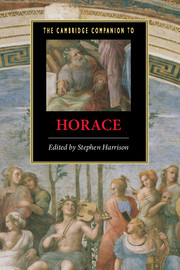10 - The Ars Poetica
from Part 2: - Poetic Genres
Published online by Cambridge University Press: 28 May 2007
Summary
The title 'Ars Poetica' ('The art of poetry') was very possibly attached to Horace’s verse letter to the Pisones before we find it used by Quintilian at the end of the first century ce. That title hints at the universal status of this didactic poem as a pre-eminent, authoritative and, in every sense, 'classical' manual on the composition of poetry. The Ars provided an object of imitation, as well as a code of practice, for Renaissance poets and playwrights; it continued to be the paradigm for neo-classical literature and aesthetics; and even some modernist writers of the twentieth century responded, or else owed something, to its prescriptions. There is no doubt that this single composition by Horace - at 476 hexameters his longest - has exercised far more influence than any of his other individual poems, and more even than his collections of poems. The later reception of Ars Poetica, like that of Plato’s Republic, is of far more consequence than its significance for the period in which it was originally produced.
At the same time, the recent tendency to consider Horace’s poem on poetics as a ‘literary epistle’ points to the way in which it can be imagined in an original context: as a poem in the oeuvre of a major Augustan writer, who refined and built on a longstanding tradition of Aristotelian and later Hellenistic poetic theory. The placing of the Ars Poetica after the Epistles in modern editions is not based on its position in the manuscripts (where it frequently comes after the Odes), but rather on its date of composition, generally agreed to be around 10 bce.
- Type
- Chapter
- Information
- The Cambridge Companion to Horace , pp. 132 - 143Publisher: Cambridge University PressPrint publication year: 2007
- 8
- Cited by

